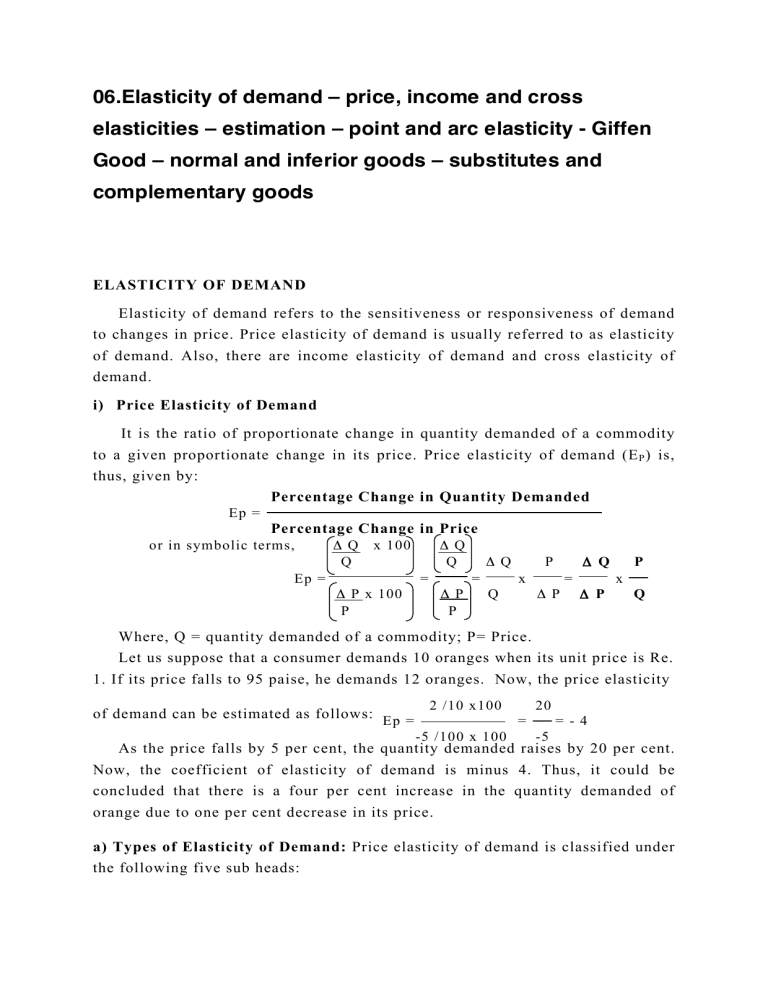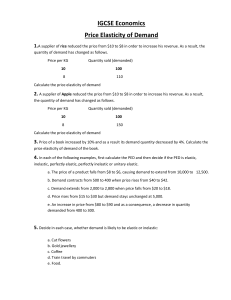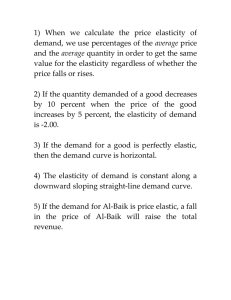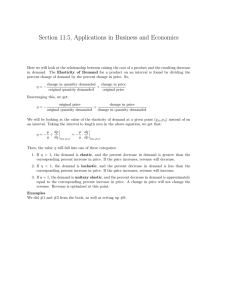
06.Elasticity of demand – price, income and cross elasticities – estimation – point and arc elasticity - Giffen Good – normal and inferior goods – substitutes and complementary goods ELASTICITY OF DEMAND Elasticity of demand refers to the sensitiveness or responsiveness of demand to changes in price. Price elasticity of demand is usually referred to as elasticity of demand. Also, there are income elasticity of demand and cross elasticity of demand. i) Price Elasticity of Demand It is the ratio of proportionate change in quantity demanded of a commodity to a given proportionate change in its price. Price elasticity of demand (E P ) is, thus, given by: Percentage Change in Quantity Demanded Ep = Percentage Change in Price or in symbolic terms, ΔQ Q x 100 Ep = ΔQ Q = Δ P x 100 P ΔQ = ΔP P P Δ Q x Q = ΔP P x Δ P Q Where, Q = quantity demanded of a commodity; P= Price. Let us suppose that a consumer demands 10 oranges when its unit price is Re. 1. If its price falls to 95 paise, he demands 12 oranges. Now, the price elasticity of demand can be estimated as follows: Ep = 2 /10 x100 20 = -5 /100 x 100 = -4 -5 As the price falls by 5 per cent, the quantity demanded raises by 20 per cent. Now, the coefficient of elasticity of demand is minus 4. Thus, it could be concluded that there is a four per cent increase in the quantity demanded of orange due to one per cent decrease in its price. a) Types of Elasticity of Demand: Price elasticity of demand is classified under the following five sub heads: Price Price 1. Perfectly elastic demand: It refers to the situation where the slightest rise in price causes the quantity demanded of a commodity to fall to zero and at the present level of price people demand infinitely large quantity of the commodity. The coefficient of elasticity of demand is infinite. P0 Ep = 0 P1 Ep = ∝ P0 Q0 Q1 Quantity Demanded Fig. 3.8(a) Perfectly Elastic Q0 Quantity Demanded Fig. 3.8(b) Perfectly Inelastic 2. Perfectly inelastic demand: It refers to the situation where even substantial changes in price do not make any change in the quantity demanded, i.e., for any change in the price, the demand remains constant. The coefficient of elasticity of demand is zero. 3. Relatively elastic demand: Here, a small proportionate change in the price of a commodity results in a larger proportionate change in its quantity demanded. The coefficient of elasticity of demand is greater than unity. 4. Relatively Inelastic demand: A larger proportionate change in the price of a commodity results in a smaller proportionate change in its quantity demanded. The coefficient of elasticity of demand is greater than zero, but less than unity. 5. Unitary elastic demand: It refers to a situation where a given proportionate change in price is accompanied by an equally proportionate change in the quantity demanded. In other words, a given proportionate fall in the price is P0 Ep > 1 Price P0 P1 0 P0 Q0 Q1 Quantity Demanded Fig.3.8(c) Relatively Elastic 0 < Ep < 1 P1 Ep=1 P1 Price Price followed by an equally proportionate increase in demand and vice versa. The 0 Q0 Q1 Quantity Demanded Fig.3.8 (d) Relatively Inelastic 0 Q0 Q1 Quantity Demanded Fig.3.8 (e) Unitary Elastic co efficient of elasticity of demand is unity. b) Factors Influencing the Elasticity of Demand: The elastic or inelastic nature of the demand for a commodity is determined by the following factors. 1) Degree of necessity: Other things being equal, the demand for necessities is inelastic or less elastic than that for comforts and luxuries. The reason is simple. The necessities must be bought whatever be the price because no one can live without them. The demand for a necessity without a substitute is less elastic than the demand for a necessity with a substitute. For example, the demand for salt is less elastic than that for paddy. 2) Proportion of consumer’s income spent on the commodity: The demand for a commodity on which the consumer spends only a small proportion of his income is less elastic. For instance, even if the price of salt or match-box rises by 100 per cent, the demand for them may not decline substantially. 3) Existence of substitutes: The demand for a commodity is more elastic, if it has a number of good substitutes. A small rise in the price of such a commodity will induce the consumers to go for its substitutes, assuming that their prices do not rise. 4) Several uses of the commodity: The demand for a commodity is said to be more elastic, if it can be put to a variety of uses. A fall in the price of electricity will result in the substantial increase in its demand. 5) Time: The elasticity of demand varies with the length of time. In general, demand is more elastic for longer period of time. For instance, if the price of kerosene rises, it may be difficult to substitute it with cooking gas within a very short time. But if sufficient time is given, people will make adjustments and use firewood or cooking gas instead of kerosene. c) Measurement of Elasticity of Demand: Price elasticity of demand can be measured by three methods. They are: 1) Total Expenditure or Outlay Method 2) Measuring Elasticity at a Point 3) Arc Method 1) Total Expenditure or Outlay Method In this method, the total expenditure on the quantity of a commodity demanded is used to find out whether the total expenditure has increased or decreased or constant, consequent on the changes in its price. In the first case, consequent on the fall in price from Rs.6 to Rs.5 and then to Rs.4, the quantities demanded have increased to 1500 and 2000 respectively. Due to fall in price, the total outlay has gone up. So, when the total outlay increases due to fall in price the demand is elastic. In the second case, total outlay remains constant irrespective of changes in prices and hence the demand is of unit elasticity. In the third case, total outlay decreases with the fall in price. So, it has inelastic Table 3.2 Elasticity of Demand – Total Outlay Method Price (in Rs / Kg) Quantity Demanded (in Quintals) Total Expenditure or Outlay in Purchasing that Quantity (Rs) Elasticity I 6.00 5.00 4.00 1000 1500 2000 6000 7500 8000 Elastic Demand Ep >1 II 6.00 5.00 4.00 1000 1200 1500 6000 6000 6000 Unit Elasticity Ep = 1 III 6.00 5.00 4.00 1000 1100 1300 6000 5500 5200 Inalastic Demand Ep < 1 demand. In the figure 3.9, AB portion of total expenditure curve slopes downward showing, as the price falls, the total expenditure is increasing and vice versa. So, the demand at this price range is elastic and Ep is greater than 1. Over the price range from OP 2 to OP 3 the total expenditure curve shows that as the price falls, the expenditure decreases and as the price increases from OP 3 to OP 2 , the total expenditure increases showing that the demand is inelastic and Ep is smaller than one. In the price range P 1 to P 2, the total expenditure does not change. Hence, the elasticity is unity and Ep = 1. P T E Curve 2) Measuring Elasticity at a Point: W hen A the price falls from OP 0 to OP 1, the quantity demanded increases from OQ 0 to OQ 1. Using the formula, elasticity of Ep >1 Price P1 B Ep = 1 demand is given by: P2 P3 C D Ep < 1 Proportionate Change in Quantity Demanded Ep = Proportionate Change in Price Total Outlay Fig. 3.9 Elasticity of DemandTotal Outlay or Expenditure Method P Ep = R Q1 Q0T by T Qd Fig.3.10 (a) Elasticity of Demand: Point Method ÷ In the figure 3.10, the triangle K 0 RK 1 is similar to triangle K 0 Q 0 T and, therefore, we can substitute, RK 0 Q0 0 RK 1 K1 R K1 R K0 = ÷ OP 0 OQ 0 Q 0 K 0 Q 0 K 0 RK 1 Q 0 K 0 = × = × OQ 0 R K0 R K0 O Q0 K0 P1 P0P1 OQ 0 RK 1 t P0 Q0 Q1 Q0T .Now, Ep = Q0K0 Q0K0 . × Q0 K0 OQ 0 Cancelling Q 0 K 0 on both sides, we get Ep = Q 0 T /O Q 0 . The assumption is that a very small change in price and quantities has been considered and so, points K 0 and K 1 on tT lie very close so as to almost coincide. If this be the assumption, then Q 0 K 0 should coincide with Q 1 K 1 and in right angled triangle tOT, the relation Q 0 T / OQ 0 can be expressed as TK 0 / K 0 t. Since TK 0 is the lower sector of the demand curve at this point and K 0 t is its upper sector, we can say that in a demand curve at any point, Lower sector K0T Elasticity = . That is, Elasticity at point K 0 = Upper sector K0 t At point K, in the Fig.3.10 (b), the lower and upper sectors are equal and hence, at K, the demand is unitary elastic. And point below K, say L, will show inelastic demand and any point above K, say M will show elastic demand. At the point where the demand curve touches the X-axis, the value of Ep = 0 (perfectly inelastic) and at the point where the demand curve touches the Y-axis the value of Ep is ∝ (infinite) (perfectly elastic). . 3) Arc Method: The Point Method of Elasticity of demand studied above refers to the condition where the price changes and in quantities demanded is very small so that we can find out the elasticity at a point. Since the changes are very Ep ∝ little, we take the original price and quantity as the basis of measurement. Suppose, the change t Price M • Ep> 1 • Ep= 1 Ep< 1 in price and quantity is very large, neither the initial nor final price and quantities can be taken. Price (Rs/Kg) 30 20 In the above Quantity Demanded (Kgs/Day) 200 400 schedule, the elasticity K Ep= 0 • L 0 T Quantity Demanded Fig.3.10 (b) Price Elasticity of Demand: Point Method 200 30 EP = × = 3. Instead, suppose we take final price and quantity demanded, 200 10 200 20 then the elasticity is E P = × =1 400 10 Now, there is a wide difference in elasticities, if we take initial or final prices. Hence, arc elasticity of demand is used to solve this problem. For this, the average of both initial and final prices and quantities are used. Original Quantity – New Quantity 200 – 400 Original Quantity + New Quantity 200 + 400 Elasticity of Demand = Original Price – New Price = 30 – 20 Original Price + New Price 30 + 20 = 1.67 The Elasticity 1.67 is neither 1 nor 3. In order to measure arc elasticity between points K and L on the demand curve DD, the formula will be: ΔQ Ep = D Q1 + Q2 P1 + P2 2 2 K P1 + P2 Price P1 ΔQ = L P2 ΔP ÷ x 2 Q1 + Q2 D ΔP 2 0 Q1 Q2 Quantity Demanded Fig.3.11 Elasticity of Demand-Arc Method P1 + P2 ΔQ = Q1 + Q2 ΔQ(P 1 + P 2 ) = x ΔP ΔP(Q 1 + Q 2 ) d) Uses of Elasticity of Demand 1) The business firms take into account the elasticity of demand when they take decisions regarding pricing of goods. 2) The elasticity of demand concept is used by the government in economic policy regarding regulation of prices of farm products. ii) Income Elasticity of Demand It may be defined as the ratio of proportionate change in the quantity demanded of commodity to a given proportionate change in income of the Percentage Change in Quantity Demanded consumer. Income Elasticity, Ei = Percentage Change In Income Δ Q x 100 Q Symbolically, Ei = ΔQ = Δ Y x 100 Y Y x Q ΔQ = ΔY Y x ΔY Q Where, Q = Quantity demanded; Y-income If, for instance, consumer’s income rises from Rs. 1000 to Rs. 1200, his purchase of the good X (say, rice) increases from 25 kgs per month to 28 kgs, then his income elasticity of demand for rice is: 3 1000 Ei = x 200 = 0.60 25 From this, we conclude that, the quantity demanded of rice rises by 0.60 per cent, if the income of the consumer rises by one per cent. Income elasticity of demand can be divided into following five sub-heads: a) Types of Income Elasticity of Demand 1) Zero income elasticity: A given increase in the consumer’s money income does not result in any increase in the quantity demanded of a commodity (Ei=0). 2) Negative income elasticity: A given increase in the consumer’s money income is followed by an actual fall in the quantity demanded of a commodity. This happens in the case of economically inferior goods (E i < 0). 3) Unitary income elasticity: A given proportionate rise in the consumer’s money income is accompanied by an equally proportionate rise in the quantity demanded of a commodity and vice versa (Ei=1). 4) Income elasticity of demand greater than unity: For a given proportionate rise in the consumer’s money income, there is a greater proportionate rise in the quantity demanded of a commodity. Ei is greater than unity. This is in case of luxuries. 5) Income elasticity of demand less than unity: For a given proportionate rise in the consumer’s money income, there is a smaller proportionate rise in the quantity demanded of a commodity. The income elasticity of demand is less than D Income D D I0 I0 I1 Ei<0 Ei = 0 I1 I1 I0 Ei=1 D 0 Q0 0 Q0 Q1 D 0 Q0 Q1 Quantity Demanded of a Commodity Fig.3.12 (a) Zero Income Fig.3.12 (b )Negative Income. Fig.3.12 (c)Unitary Elasticity of Demand Elasticity of Demand Income Elasticity of Demand unity in case of necessaries i.e., the percentage expenditure on necessaries increases in a smaller proportion when the consumer’s money income goes up (Ei < 1). EI<1 I1 EI>1 I0 I0 Income Income I1 0 Q0 Q1 0 Q 0 Q1 Quantity Demanded of a Commodity Fig.3.12 (d) Income Elasticity Greater Fig. 3.12 (e) Income Elasticity Less than Unity than Unity





